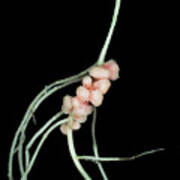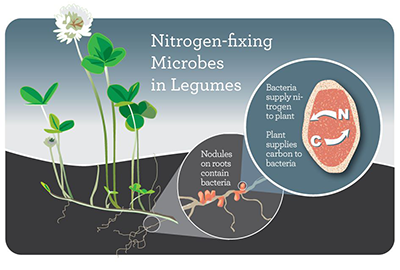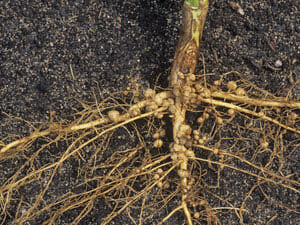Rhizobia: Difference between revisions
| (42 intermediate revisions by the same user not shown) | |||
| Line 1: | Line 1: | ||
[[File:Rhizobia.jpeg|500px|thumb|left]] | [[File:Rhizobia.jpeg|500px|thumb|left|Pink rhizobia nodules actively fixing nitrogen]] | ||
Rhizobia are bacteria that fix nitrogen in [[soil]] that aid in the growth and development of plants. Rhizobia can only fix nitrogen when associated with a plant that provides it with carbohydrates and are only associated with legumes, but not all legumes associate with | Rhizobia are Gram-negative bacteria that fix nitrogen in [[soil]] that aid in the growth and development of plants. Rhizobia comes from two Greek words 'rhiza' means a root and 'bios' means life <ref name= “Maitra”>Maitra, S., Praharaj, S., Brestic, M., Sahoo, R. K., Sagar, L., Shankar, T., Palai, J. B., Sahoo, U., Sairam, M., Pramanick, B., Nath, S., Venugopalan, V. K., Skalický, M., & Hossain, A. (2023). Rhizobium as Biotechnological Tools for Green Solutions: An Environment-Friendly Approach for Sustainable Crop Production in the Modern Era of Climate Change. Current microbiology, 80(7), 219. https://doi.org/10.1007/s00284-023-03317-w </ref>. Rhizobia can only fix nitrogen when associated with a plant that provides it with carbohydrates and are only associated with legumes, but not all legumes associate with rhizobia. | ||
==Taxonomy== | ==Taxonomy== | ||
| Line 26: | Line 26: | ||
|style="min-width:6em; |Rhizobium | |style="min-width:6em; |Rhizobium | ||
|} | |} | ||
Rhizobia are not confined to a single genus, as they span multiple genera: Rhizobium, Ensifer, Mesorhizobium, Bradyrhizobium, and Azorhizobium <ref name= “Ormeño-Orrillo”>Ormeño-Orrillo, E., Servín-Garcidueñas, L. E., Rogel, M. A., González, V., Peralta, H., Mora, J., Martínez-Romero, J., & Martínez-Romero, E. (2015). Taxonomy of rhizobia and agrobacteria from the Rhizobiaceae family in light of genomics. Systematic and Applied Microbiology, 38(4), 287–291. https://doi.org/10.1016/j.syapm.2014.12.002 </ref>. The ability to fix nitrogen and form nodules is determined by symbiosis-related genes, which can be transferred between species. A characteristic of rhizobia belonging to the family Rhizobiaceae is their genome organization in multireplicons and their phenotypic distinctive characteristics in extrachromosomal replicons <ref name= “Ormeño-Orrillo”>Ormeño-Orrillo, E., Servín-Garcidueñas, L. E., Rogel, M. A., González, V., Peralta, H., Mora, J., Martínez-Romero, J., & Martínez-Romero, E. (2015). Taxonomy of rhizobia and agrobacteria from the Rhizobiaceae family in light of genomics. Systematic and Applied Microbiology, 38(4), 287–291. https://doi.org/10.1016/j.syapm.2014.12.002 </ref>. | |||
==Ecology and Habitat== | ==Ecology and Habitat== | ||
Rhizobia live in various environments, including soil, [[plant roots]], infection threads, and legume nodules at different stages <ref name= "Burghardt">Burghardt, L. T., & diCenzo, G. C. (2023). The evolutionary [[ecology]] of rhizobia: multiple facets of competition before, during, and after symbiosis with legumes. Current Opinion in Microbiology, 72, 102281–102281. https://doi.org/10.1016/j.mib.2023.102281 </ref>. They also live in the phyllosphere and root, flower, and leaf endospheres of legumes <ref name= "Burghardt">Burghardt, L. T., & diCenzo, G. C. (2023). The evolutionary [[ecology]] of rhizobia: multiple facets of competition before, during, and after symbiosis with legumes. Current Opinion in Microbiology, 72, 102281–102281. https://doi.org/10.1016/j.mib.2023.102281 </ref>. Their competition strategies changes depending on nutrient availability, microbial density, and host plant. Rhizobia have a competitive advantage, as they use organic acids as key carbon sources in the [[rhizosphere]] and have various transporters and metabolic genes that help them absorb and break down nutrients <ref name= "Burghardt">Burghardt, L. T., & diCenzo, G. C. (2023). The evolutionary [[ecology]] of rhizobia: multiple facets of competition before, during, and after symbiosis with legumes. Current Opinion in Microbiology, 72, 102281–102281. https://doi.org/10.1016/j.mib.2023.102281 </ref>. Along with traits impacting the ability of rhizobia to inhabit the rhizosphere, competition for nodule occupancy also have an impact. Legumes can form dozens to over a thousand nodules, usually infected by a single rhizobium strain, creating a competitive bottleneck <ref name= "Burghardt">Burghardt, L. T., & diCenzo, G. C. (2023). The evolutionary [[ecology]] of rhizobia: multiple facets of competition before, during, and after symbiosis with legumes. Current Opinion in Microbiology, 72, 102281–102281. https://doi.org/10.1016/j.mib.2023.102281 </ref>. | |||
==Symbiotic Relationship with Legumes== | ==Symbiotic Relationship with Legumes== | ||
[[File:Rhizobium_and_Legumes.png| | [[File:Rhizobium_and_Legumes.png|400px|thumb|left|Rhizobia-legume Symbiosis]] | ||
Through their symbiotic relationship with legumes, they enhance the availability of nutrients by breaking down [[Organic Matter|organic matter]] and releasing the nutrients into the soil | The symbiosis between rhizobia and legumes begins with a signal exchange between the host and plant and its microsymbiont, where the host induces cell divisions to form root nodule primordia, and simultaneously initiates an infection process to deliver the bacteria into the nodule cells <ref name= “Wang”>Wang, Q., Liu, J., & Zhu, H. (2018). Genetic and Molecular Mechanisms Underlying Symbiotic Specificity in Legume-Rhizobium Interactions. Frontiers in Plant Science, 9, 313–313. https://doi.org/10.3389/fpls.2018.00313 </ref>. [[Root hairs]] then curl around the bacteria, forming infection threads that guide rhizobia into the root, where they are enclosed in membrane-bound structures called symbiosomes, where the bacteria transforms into nitrogen-fixing bacteria <ref name= “Wang”>Wang, Q., Liu, J., & Zhu, H. (2018). Genetic and Molecular Mechanisms Underlying Symbiotic Specificity in Legume-Rhizobium Interactions. Frontiers in Plant Science, 9, 313–313. https://doi.org/10.3389/fpls.2018.00313 </ref>. This symbiotic relationship is highly specific because no single rhizobial strain can form symbiosis with all legumes, and compatibility varies at species and genotypic levels <ref name= “Wang”>Wang, Q., Liu, J., & Zhu, H. (2018). Genetic and Molecular Mechanisms Underlying Symbiotic Specificity in Legume-Rhizobium Interactions. Frontiers in Plant Science, 9, 313–313. https://doi.org/10.3389/fpls.2018.00313 </ref>. | ||
Through their symbiotic relationship with legumes, they enhance the availability of nutrients by breaking down [[Organic Matter|organic matter]] and releasing the nutrients into the soil <ref name= “Mng’ong’o”>Mng’ong’o, M. E., Ojija, F., & Aloo, B. N. (2023). The role of Rhizobia toward food production, food and soil security through microbial agro-input utilization in developing countries. Case Studies in Chemical and Environmental Engineering, 8, 100404-. https://doi.org/10.1016/j.cscee.2023.100404 </ref>. Rhizobia and legumes work together to promote the growth of numerous plant species, thus strengthening the ecosystem <ref name= “Mng’ong’o”>Mng’ong’o, M. E., Ojija, F., & Aloo, B. N. (2023). The role of Rhizobia toward food production, food and soil security through microbial agro-input utilization in developing countries. Case Studies in Chemical and Environmental Engineering, 8, 100404-. https://doi.org/10.1016/j.cscee.2023.100404 </ref>. | |||
==Soil Benefits== | ==Soil Benefits== | ||
Nitrogen is an important nutrient for plant growth and development, but plants do not have the ability to use the nitrogen in the atmosphere directly | [[File:RhizoNodules.jpg|400px|thumb|right|Root nodules in legumes formed by rhizobia]] | ||
Nitrogen is an important nutrient for plant growth and development, but plants do not have the ability to use the nitrogen in the atmosphere directly <ref name= “Ormeño-Orrillo”>Ormeño-Orrillo, E., Servín-Garcidueñas, L. E., Rogel, M. A., González, V., Peralta, H., Mora, J., Martínez-Romero, J., & Martínez-Romero, E. (2015). Taxonomy of rhizobia and agrobacteria from the Rhizobiaceae family in light of genomics. Systematic and Applied Microbiology, 38(4), 287–291. https://doi.org/10.1016/j.syapm.2014.12.002 </ref>. Rhizobium forms symbiotic relationships with legume plants by developing root nodules, where it converts the nitrogen in the atmosphere into a form that plants can absorb <ref name= “Ormeño-Orrillo”>Ormeño-Orrillo, E., Servín-Garcidueñas, L. E., Rogel, M. A., González, V., Peralta, H., Mora, J., Martínez-Romero, J., & Martínez-Romero, E. (2015). Taxonomy of rhizobia and agrobacteria from the Rhizobiaceae family in light of genomics. Systematic and Applied Microbiology, 38(4), 287–291. https://doi.org/10.1016/j.syapm.2014.12.002 </ref>. This process improves soil health by increasing nitrogen availability, contribute to increased soil microbial [[diversity]], and improving soil structure. Rhizobia also enhances soil security by creating and maintaining soil aggregates, increasing soil [[porosity]], water infiltration, and nutrient retention, increasing its resistance to erosion and deterioration <ref name= “Mng’ong’o”>Mng’ong’o, M. E., Ojija, F., & Aloo, B. N. (2023). The role of Rhizobia toward food production, food and soil security through microbial agro-input utilization in developing countries. Case Studies in Chemical and Environmental Engineering, 8, 100404-. https://doi.org/10.1016/j.cscee.2023.100404 </ref>. Some strains of rhizobia also possess biocontrol [[properties]], suppressing plant infections and illnesses <ref name= “Mng’ong’o”>Mng’ong’o, M. E., Ojija, F., & Aloo, B. N. (2023). The role of Rhizobia toward food production, food and soil security through microbial agro-input utilization in developing countries. Case Studies in Chemical and Environmental Engineering, 8, 100404-. https://doi.org/10.1016/j.cscee.2023.100404 </ref>. The use of rhizobia through biological nitrogen fixation, BNF, by farmers reduce the negative effects of pesticide use on the environment <ref name= “Mng’ong’o”>Mng’ong’o, M. E., Ojija, F., & Aloo, B. N. (2023). The role of Rhizobia toward food production, food and soil security through microbial agro-input utilization in developing countries. Case Studies in Chemical and Environmental Engineering, 8, 100404-. https://doi.org/10.1016/j.cscee.2023.100404 </ref>. | |||
==Rhizobium Biotechnology== | ==Rhizobium Biotechnology== | ||
Biological nitrogen fixation, BNF, is a process where nitrogen-fixing bacteria that trap atmospheric nitrogen and convert it to NH3 for utilization by plants <ref name= “Maitra”>Maitra, S., Praharaj, S., Brestic, M., Sahoo, R. K., Sagar, L., Shankar, T., Palai, J. B., Sahoo, U., Sairam, M., Pramanick, B., Nath, S., Venugopalan, V. K., Skalický, M., & Hossain, A. (2023). Rhizobium as Biotechnological Tools for Green Solutions: An Environment-Friendly Approach for Sustainable Crop Production in the Modern Era of Climate Change. Current microbiology, 80(7), 219. https://doi.org/10.1007/s00284-023-03317-w </ref>. The use of rhizobia in [[agriculture]] is an alternative to pesticide to increased crop growth. Rhizobia may produce phytohormones such as gibberellic acid, IAA, and cytokinins that promote plant growth and development. Rhizobium biotechnology can provide additional benefits of crop stress tolerance, improvement in crop growth, and better quality of produce <ref name= “Maitra”>Maitra, S., Praharaj, S., Brestic, M., Sahoo, R. K., Sagar, L., Shankar, T., Palai, J. B., Sahoo, U., Sairam, M., Pramanick, B., Nath, S., Venugopalan, V. K., Skalický, M., & Hossain, A. (2023). Rhizobium as Biotechnological Tools for Green Solutions: An Environment-Friendly Approach for Sustainable Crop Production in the Modern Era of Climate Change. Current microbiology, 80(7), 219. https://doi.org/10.1007/s00284-023-03317-w </ref>. Rhizobia also has the potential to support crops under climatic condition and abiotic stresses because Rhizobium inocula are often subjected to harsh soil environment, such as drought-tolerant and heat-tolerant strains of Rhizobium <ref name= “Maitra”>Maitra, S., Praharaj, S., Brestic, M., Sahoo, R. K., Sagar, L., Shankar, T., Palai, J. B., Sahoo, U., Sairam, M., Pramanick, B., Nath, S., Venugopalan, V. K., Skalický, M., & Hossain, A. (2023). Rhizobium as Biotechnological Tools for Green Solutions: An Environment-Friendly Approach for Sustainable Crop Production in the Modern Era of Climate Change. Current microbiology, 80(7), 219. https://doi.org/10.1007/s00284-023-03317-w </ref>. As research on rhizobium biotechnology advances, this approach can mitigate the challenges posed by climate change, soil degradation, and improving crop production sustainably. | |||
==References== | ==References== | ||
Revision as of 22:50, 31 March 2025

Rhizobia are Gram-negative bacteria that fix nitrogen in soil that aid in the growth and development of plants. Rhizobia comes from two Greek words 'rhiza' means a root and 'bios' means life [1]. Rhizobia can only fix nitrogen when associated with a plant that provides it with carbohydrates and are only associated with legumes, but not all legumes associate with rhizobia.
Taxonomy
| Domain: | Bacteria |
|---|---|
| Phylum: | Pseudomonadota |
| Class: | Alphaproteobacteria |
| Order: | Hyphomicrobiales |
| Family: | Rhizobiaceae |
| Genus: | Rhizobium |
Rhizobia are not confined to a single genus, as they span multiple genera: Rhizobium, Ensifer, Mesorhizobium, Bradyrhizobium, and Azorhizobium [2]. The ability to fix nitrogen and form nodules is determined by symbiosis-related genes, which can be transferred between species. A characteristic of rhizobia belonging to the family Rhizobiaceae is their genome organization in multireplicons and their phenotypic distinctive characteristics in extrachromosomal replicons [2].
Ecology and Habitat
Rhizobia live in various environments, including soil, plant roots, infection threads, and legume nodules at different stages [3]. They also live in the phyllosphere and root, flower, and leaf endospheres of legumes [3]. Their competition strategies changes depending on nutrient availability, microbial density, and host plant. Rhizobia have a competitive advantage, as they use organic acids as key carbon sources in the rhizosphere and have various transporters and metabolic genes that help them absorb and break down nutrients [3]. Along with traits impacting the ability of rhizobia to inhabit the rhizosphere, competition for nodule occupancy also have an impact. Legumes can form dozens to over a thousand nodules, usually infected by a single rhizobium strain, creating a competitive bottleneck [3].
Symbiotic Relationship with Legumes

The symbiosis between rhizobia and legumes begins with a signal exchange between the host and plant and its microsymbiont, where the host induces cell divisions to form root nodule primordia, and simultaneously initiates an infection process to deliver the bacteria into the nodule cells [4]. Root hairs then curl around the bacteria, forming infection threads that guide rhizobia into the root, where they are enclosed in membrane-bound structures called symbiosomes, where the bacteria transforms into nitrogen-fixing bacteria [4]. This symbiotic relationship is highly specific because no single rhizobial strain can form symbiosis with all legumes, and compatibility varies at species and genotypic levels [4].
Through their symbiotic relationship with legumes, they enhance the availability of nutrients by breaking down organic matter and releasing the nutrients into the soil [5]. Rhizobia and legumes work together to promote the growth of numerous plant species, thus strengthening the ecosystem [5].
Soil Benefits

Nitrogen is an important nutrient for plant growth and development, but plants do not have the ability to use the nitrogen in the atmosphere directly [2]. Rhizobium forms symbiotic relationships with legume plants by developing root nodules, where it converts the nitrogen in the atmosphere into a form that plants can absorb [2]. This process improves soil health by increasing nitrogen availability, contribute to increased soil microbial diversity, and improving soil structure. Rhizobia also enhances soil security by creating and maintaining soil aggregates, increasing soil porosity, water infiltration, and nutrient retention, increasing its resistance to erosion and deterioration [5]. Some strains of rhizobia also possess biocontrol properties, suppressing plant infections and illnesses [5]. The use of rhizobia through biological nitrogen fixation, BNF, by farmers reduce the negative effects of pesticide use on the environment [5].
Rhizobium Biotechnology
Biological nitrogen fixation, BNF, is a process where nitrogen-fixing bacteria that trap atmospheric nitrogen and convert it to NH3 for utilization by plants [1]. The use of rhizobia in agriculture is an alternative to pesticide to increased crop growth. Rhizobia may produce phytohormones such as gibberellic acid, IAA, and cytokinins that promote plant growth and development. Rhizobium biotechnology can provide additional benefits of crop stress tolerance, improvement in crop growth, and better quality of produce [1]. Rhizobia also has the potential to support crops under climatic condition and abiotic stresses because Rhizobium inocula are often subjected to harsh soil environment, such as drought-tolerant and heat-tolerant strains of Rhizobium [1]. As research on rhizobium biotechnology advances, this approach can mitigate the challenges posed by climate change, soil degradation, and improving crop production sustainably.
References
- ↑ Jump up to: 1.0 1.1 1.2 1.3 Maitra, S., Praharaj, S., Brestic, M., Sahoo, R. K., Sagar, L., Shankar, T., Palai, J. B., Sahoo, U., Sairam, M., Pramanick, B., Nath, S., Venugopalan, V. K., Skalický, M., & Hossain, A. (2023). Rhizobium as Biotechnological Tools for Green Solutions: An Environment-Friendly Approach for Sustainable Crop Production in the Modern Era of Climate Change. Current microbiology, 80(7), 219. https://doi.org/10.1007/s00284-023-03317-w
- ↑ Jump up to: 2.0 2.1 2.2 2.3 Ormeño-Orrillo, E., Servín-Garcidueñas, L. E., Rogel, M. A., González, V., Peralta, H., Mora, J., Martínez-Romero, J., & Martínez-Romero, E. (2015). Taxonomy of rhizobia and agrobacteria from the Rhizobiaceae family in light of genomics. Systematic and Applied Microbiology, 38(4), 287–291. https://doi.org/10.1016/j.syapm.2014.12.002
- ↑ Jump up to: 3.0 3.1 3.2 3.3 Burghardt, L. T., & diCenzo, G. C. (2023). The evolutionary ecology of rhizobia: multiple facets of competition before, during, and after symbiosis with legumes. Current Opinion in Microbiology, 72, 102281–102281. https://doi.org/10.1016/j.mib.2023.102281
- ↑ Jump up to: 4.0 4.1 4.2 Wang, Q., Liu, J., & Zhu, H. (2018). Genetic and Molecular Mechanisms Underlying Symbiotic Specificity in Legume-Rhizobium Interactions. Frontiers in Plant Science, 9, 313–313. https://doi.org/10.3389/fpls.2018.00313
- ↑ Jump up to: 5.0 5.1 5.2 5.3 5.4 Mng’ong’o, M. E., Ojija, F., & Aloo, B. N. (2023). The role of Rhizobia toward food production, food and soil security through microbial agro-input utilization in developing countries. Case Studies in Chemical and Environmental Engineering, 8, 100404-. https://doi.org/10.1016/j.cscee.2023.100404